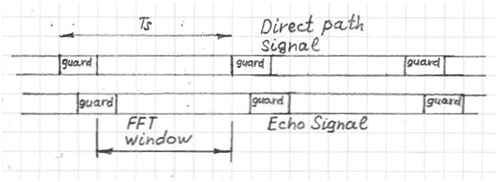Orthogonal Frequency Division Multiplexing (OFDM) modulation is an essential part of many communication and broadcasting systems. DVB-T (Digital Video Broadcasting for terrestrial television ) uses OFDM as a key principle for digital video modulation.
The OFDM transform is an inverse Discrete Fourier Transform on the transmitter side and a direct Fourier Transform at the receiver side.
At the input of OFDM there is a sequence of symbols. Each symbol is a set of complex samples for one OFDM transform. The number of complex samples depends on the DVB-T OFDM mode. Fore 2K mode there are 1705 samples and for 8K mode there are 6817 samples. Each complex sample is a transmitter symbol with QAM I and Q coordinates. After the OFDM transform, each sample is converted to the complex carrier of the particular frequency.
Each symbol has a duration TS, that consists of a useful part with TU and a guard interval Δ.
TS = TU + Δ.
The guard interval is inserted before the useful part and may take the values:
Δ = TU/4; TU/8; TU/16; TU/32.
Symbols are combined into frames. Each frame contains 68 symbols that are numbered from 0 to 67.
The OFDM modulated signal could be written as
k – carrier number
l – OFDM symbol number
m – frame number
Ts – symbol duration
TU -useful part duration that is inverse of carrier spacing
Δ – guard interval duration
fc – RF signal central carrier
Kmax – number of carriers (1705 for 4K mode and 6817 for 8K mode)
Lmax – number of symbols (Lmax = 68)
k’ – the carrier index relative to the central frequency, k’=k–Kmax/2
Cm,l,k – complex signal for carrier k, of the data symbol l, in a frame number m. Cm,l,k represents input QAM symbol I and Q coordinates
OFDM is represented as a sum of multiple complex carriers that are orthogonal to each other.
Terrestrial TV broadcasting struggles with multipath propagation. A digital signal affected by multipath propagation suffers from distortion caused by adjacent symbols overlapping due to the sum of the direct propagation signal and echo signals. This intersymbol interference can be a major source of demodulation errors.

Compared with single carrier digital modulation, OFDM with K carriers can increase the effective symbol period by K times and minimize intersymbol interference. An efficient method of intersymbol interference reduction is guard interval insertion at the beginning of each symbol. Thus, intersymbol interference from adjacent symbols will not occur if the overlapping length is within the guard interval.
In this case, the Fast Fourier Transform (FFT) in the receiver will enclose only the overlap of the same symbol signal. Despite this, OFDM may still suffer from distortion caused by multipath propagation. After the receiver FFT, the distortion may be present as multiplicative complex envelope distortion. To correct it the equalizer is used. The equalizer estimates the distortion based on an estimate of the pilot values. Pilot values were inserted in the signal before the inverse FFT in the transmitter. If the envelope distortion has nulls the signal may not be recovered.
